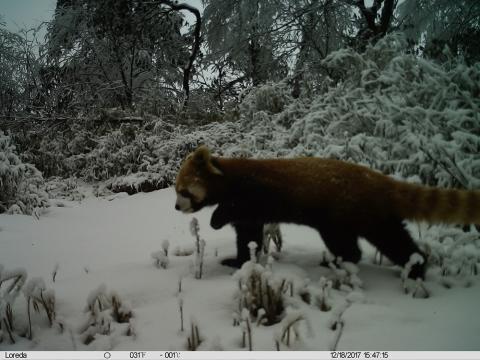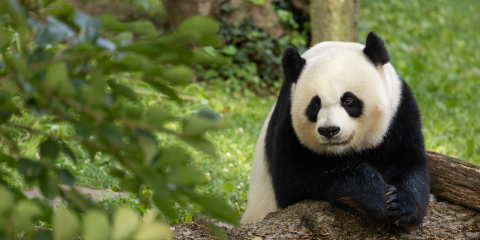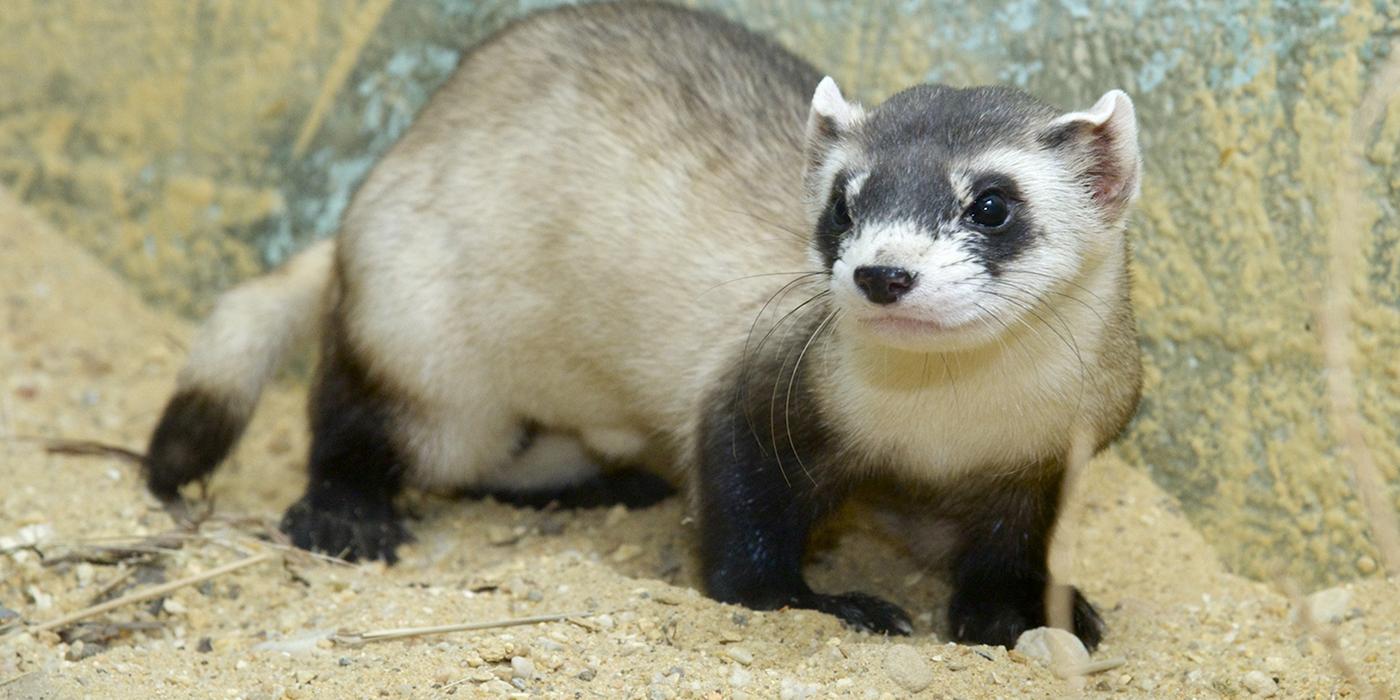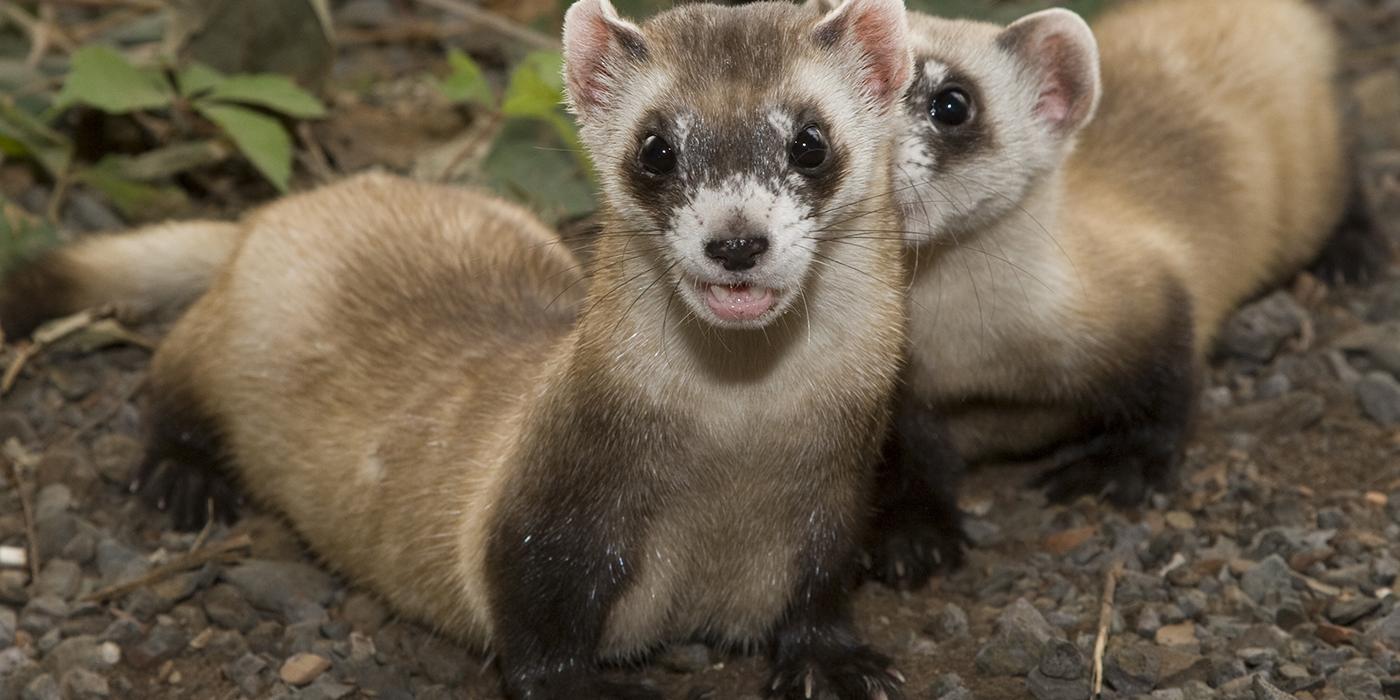Physical Description
Black-footed ferrets' color and markings blend well with grassland soils and plants, making them well adapted to their prairie environment. They are slender, wiry animals with a black facemask, black feet and a black-tipped tail. The rest of their body is short and sleek, with fur that is a yellow-buff color, lighter on the belly and nearly white on the forehead, muzzle and throat. Their legs are short with large front paws and claws developed for digging. Black footed ferrets' large ears and eyes suggest that they have acute hearing and sight, but smell is probably their most important sense for hunting prey underground in the dark.
Size
They are about the size of a mink—18 to 24 inches (46 to 61 centimeters) long, including a 5 to 6 inch (13 to 15 centimeters) tail. They weigh 1.5 to 2.5 pounds (around 1 kilograms) with males being slightly larger than females.
Native Habitat
Black-footed ferrets once ranged throughout the North American Great Plains wherever prairie dog colonies thrived, from southern Canada to northern Mexico. Today, they have been reintroduced into parts of their former range in Wyoming, South Dakota, Montana and Arizona.
Lifespan
Few black-footed ferrets live beyond 3-4 years of age in the wild. They typically live to be about 4 years old in human care.
Communication
Black-footed ferrets are very vocal. A loud chatter is used as an alarm call. A hiss is used to show agitation or fear, and females use whimpering sounds to encourage the young to follow. Male ferrets often "chortle" to females during breeding.
Food/Eating Habits
Ferrets have a high metabolic rate and require large quantities of food in proportion to their body size. Food requirements vary with the seasons and among individual ferrets, but they generally consume one prairie dog every three or four days.
In the wild, 90 percent of black-footed ferrets' diet is prairie dogs. One ferret may eat over 100 prairie dogs in a year, and scientists calculate that one ferret family needs more than 250 prairie dogs each year. The remainder of their diet includes mice, rats, ground squirrels, rabbits, birds and occasionally reptiles and insects.
The Smithsonian's National Zoo's black-footed ferret is fed a commercial carnivore meat mix, mice, and rats.
Sleep Habits
Black-footed ferrets are primarily nocturnal. They spend most of their time underground in prairie dog burrows, typically spending only a few minutes above ground each day during the first few hours following sunrise to hunt or find new burrows or mates.
In burrows, they sleep, catch their food, escape from predators and harsh weather, and give birth to their young. Ferrets do not hibernate, but in winter, the amount of time they are active and the distances they travel decrease substantially. They have been found to remain underground in the same burrow system for a week at a time in winter. Males are more active than females: males tend to travel about double the distance that females do.
Social Structure
Black-footed ferrets lead solitary lives, except during the breeding season or when females are caring for young.
Reproduction and Development
Breeding activity generally occurs in March and April; after a gestation period of 41 to 43 days, a litter of kits is born. The average litter size is three to four young, but single kits, as well as litters of nine or ten, have been recorded. Only the female cares for the young. The kits are born blind and helpless, weighing only 0.2 to 0.3 ounces (5 to 9 gram) at birth, with thin, white hair covering their bodies. Their dark markings appear at about 3 weeks of age and young kits begin to open their eyes about 35 days after birth. Black-footed ferret kits develop very rapidly and become increasingly active after their eyes open.
Kits are about three-quarters grown by July when they first venture above ground. Long after they stop nursing, they depend on their mother for meals of meat. By late summer, the female leaves her kits in separate burrows during the day and gathers them together at night to hunt. Eventually, the young begin to hunt alone, and by September are usually independent and solitary. Ferrets become sexually mature at 1 year of age, and their peak reproductive period is at about 3 to 4 years.
Conservation Efforts
The Zoo has been a leader in black-footed ferret conservation since a small population was discovered in 1981. The last remaining 18 wild animals were caught between 1985 and 1987 to establish a breeding center in Wyoming. In 1988, the Zoo was the first to receive offspring from those 18 and breed black-footed ferrets outside of Wyoming.
As of May 2021, 1,029 black-footed ferrets have been born at the Smithsonian Conservation Biology Institute in Front Royal, Virginia, including 139 born by artificial insemination. The ongoing recovery of black-footed ferrets is one of the Zoo's most successful conservation endeavors to date.
SCBI works closely with the U.S. Fish and Wildlife Service to reintroduce ferrets back into the wild. The breeding program maintains a core breeding population of 280 ferrets of prime breeding age (1 to 3 years old). Some of the ferrets have been sent to the National Black-Footed Ferret Conservation Center in Colorado to prepare for release back into the wild, a process called "preconditioning." Preconditioning involves familiarizing the animals with burrows (underground tunnels) to increase the chance that they will survive in the wild. Ferrets will then be reintroduced into various sites in the western Great Plains. Currently, 28 reintroduction sites cover parts of Wyoming, South Dakota, Montana, Arizona, Colorado, Utah, Kansas, New Mexico, Canada and Mexico.
Each year, between 150 and 220 black-footed ferrets are released from their preconditioning programs into these sites; about 4,500 ferrets have been released since the program's inception.As of 2011, the U.S. Fish and Wildlife Service reintroduction program has resulted in more than 7,000 black-footed ferret kits births across six zoos and more than 2,600 of those animals being reintroduced into the wild. In the future, scientists hope to research more about sylvatic plague, genetic diversity, ferret health, behavior in the wild, reproduction and semen cryopreservation, so that they can better help black-footed ferrets.
Although much of the grassland of North America has been destroyed, there are areas where original prairie still survives. Much of the western prairie was never plowed, but was used for cattle grazing, so much more of it remains intact than the eastern tall grass prairie. Rising interest in protecting the prairie may ensure that some of these areas will be saved. Many people are learning to imitate nature rather than control it. Ranchers are experimenting with new ways of raising cattle, bringing back native grasses for grazing in order to restore and preserve the soil.
Bison ranching is gaining popularity, because bison meat is much leaner and healthier than beef. Bison graze more efficiently than cattle and can better survive extremes in weather. Some of the most important prairie-saving activities are happening in backyards and school grounds across the country, where manicured lawns are being replaced with native grasses and wildflowers to attract a variety of wildlife and perhaps bring back just a small piece of the prairie.
The biggest threat to black-footed ferrets is lack of suitable habitat and the continued decline of the prairie dog, their main prey.
Disease also poses a significant threat to black-footed ferrets. Sylvatic plague, spread by fleas, is deadly to both ferrets and prairie dogs, and has drastically reduced prairie dog populations throughout North America, nearly exterminating the food source for black-footed ferrets. Ferrets are also susceptible to canine distemper, pneumonia, tularemia and a variety of internal parasites.
In 2024, Antonia, a cloned black-footed ferret, successfully gave birth to two healthy offspring after mating with Urchin, a 3-year-old male. The kits were born at the Smithsonian's National Zoo and Conservation Biology Institute in Front Royal, Virginia. This was the first time in history a cloned endangered animal has given birth in the United States.
Help this Species
- Support organizations like the Smithsonian’s National Zoo and Conservation Biology Institute that research better ways to protect and care for this animal and other endangered species. Consider donating your time, money or goods.
- Share the story of this animal with others. Simply raising awareness about this species can contribute to its overall protection.
Animal News

QUIZ: Can You Identify the Wildlife in Asia’s Mountain Forests?




